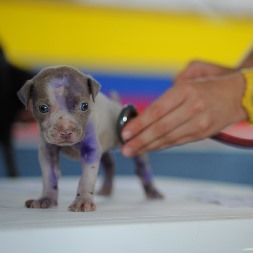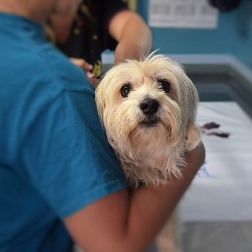How to Pick a Veterinary Technician School near Olney Montana
 Realizing your long term goal of working with and caring for pets by enrolling in a vet tech college near Olney MT could initially feel like a challenging undertaking. After all, you have to find and enroll in a program that will deliver the proper training to ensure that you can succeed as a vet tech. But just how do you go about assessing and contrasting colleges so that you can make the best choice? Many future students begin their due diligence process by looking for schools that are near their residences. Once they have identified some area schools, they find out which ones have the cheapest tuition and hone in on those. Although cost and location are important factors when comparing vet tech programs, they are by no means the only important ones when making your comparisons. Qualifications such as accreditation and internship programs need to be considered as well. The point is that there are questions you ought to be asking the vet technician schools you are evaluating before you make a final decision. We have provided several in this article in order to help get you started, but before we review them we’ll discuss the various roles of veterinary technicians and the training alternatives offered.
Realizing your long term goal of working with and caring for pets by enrolling in a vet tech college near Olney MT could initially feel like a challenging undertaking. After all, you have to find and enroll in a program that will deliver the proper training to ensure that you can succeed as a vet tech. But just how do you go about assessing and contrasting colleges so that you can make the best choice? Many future students begin their due diligence process by looking for schools that are near their residences. Once they have identified some area schools, they find out which ones have the cheapest tuition and hone in on those. Although cost and location are important factors when comparing vet tech programs, they are by no means the only important ones when making your comparisons. Qualifications such as accreditation and internship programs need to be considered as well. The point is that there are questions you ought to be asking the vet technician schools you are evaluating before you make a final decision. We have provided several in this article in order to help get you started, but before we review them we’ll discuss the various roles of veterinary technicians and the training alternatives offered.
The Job of a Vet Tech in Olney MT
 Among the initial decisions that you will have to make is whether you want to train as a vet assistant, technologist or technician. Part of your decision might be based on the amount of time and money that you have to invest in your training, but the primary factor will undoubtedly be which specialization appeals to you the most. What technicians and assistants share in common is that they each work under the immediate direction of a practicing and licensed veterinarian. And while there are many functions that they can perform within the Olney MT veterinary clinic or hospital, they can’t prescribe medications, diagnose health issues, or carry out surgeries. In those areas they can only provide support to a licensed vet. There are technicians and technologists that work outside of the conventional veterinarian practice, for example for animal shelters, zoos or law enforcement. Let’s take a look at the duties and training prerequisites for each specialty.
Among the initial decisions that you will have to make is whether you want to train as a vet assistant, technologist or technician. Part of your decision might be based on the amount of time and money that you have to invest in your training, but the primary factor will undoubtedly be which specialization appeals to you the most. What technicians and assistants share in common is that they each work under the immediate direction of a practicing and licensed veterinarian. And while there are many functions that they can perform within the Olney MT veterinary clinic or hospital, they can’t prescribe medications, diagnose health issues, or carry out surgeries. In those areas they can only provide support to a licensed vet. There are technicians and technologists that work outside of the conventional veterinarian practice, for example for animal shelters, zoos or law enforcement. Let’s take a look at the duties and training prerequisites for each specialty.
- Vet Assistants in the majority of cases will have completed a structured training program, either as an apprentice or intern in a practice, or by finishing a certificate program at a vocational school or community college. As the name implies, their job function is to assist the vets and vet technicians in the execution of their duties. Usually they are not involved with more complicated activities, for instance assisting with surgical procedures. A few of their typical responsibilities may include working at the front desk, cleaning and preparing examination rooms and equipment, or handling pets during exams.
- Vet Technicians receive more advanced training compared to assistants and usually acquire a 2 year Associate Degree, ideally from an American Veterinary Medical Association (AVMA) accredited program. They are in a sense the veterinarian equivalent of medical nurses, since their general job duty is to assist veterinarians with diagnosing and treating animal patients. Where they stand apart from vet assistants is that they are engaged in more complex functions, such as assisting with surgical procedures or providing medication. All states currently mandate that vet technicians pass a credentialing examination for either licensing, registration or certification.
- Vet Technologists are similar to vet technicians and essentially carry out the same work functions. They are mandated to attain a Bachelor’s Degree in veterinary technology, which typically requires four years. So the only real difference between a vet technician and a technologist is the technologist’s more advanced level of education. But with an advanced degree comes more job options, increased salaries and possible management positions. They are also required to pass a credentialing examination for either licensing, registration or certification.
Vet technicians and technologists can specialize in areas such as anesthesia, internal medicine or emergency care. Many may acquire certification from the American Association for Laboratory Animal Science (AALAS) to work in Olney MT laboratories or research facilities also.
Vet Tech Online Programs Offered in Olney
 An option that might be a solution for those with a hectic schedule or who are working full-time while going to veterinary school is to enroll in an online program. Because the classes are made available via the internet, students can attend on their own schedule wherever a computer is available. The curriculum is taught using multiple methods, including slide shows, videos and live streaming webinars. And since many vet technician and technologist degrees require clinical training, that portion can typically be completed as an internship or work study program at a local Olney MT veterinarian practice or hospital. Distance learning, as it is also called, may in some instances reduce the cost of your education. Tuition and supplementary expenses, such as for traveling and study supplies, can be cheaper compared to more traditional classroom courses. Just make sure that the online school that you choose is accredited, either by the AVMA or another nationally recognized accrediting agency. With the online courses and the clinical training, everything is included for a comprehensive education. So if you are dedicated enough to learn in this more independent mode, an online veterinary technician program may be the right option for you.
An option that might be a solution for those with a hectic schedule or who are working full-time while going to veterinary school is to enroll in an online program. Because the classes are made available via the internet, students can attend on their own schedule wherever a computer is available. The curriculum is taught using multiple methods, including slide shows, videos and live streaming webinars. And since many vet technician and technologist degrees require clinical training, that portion can typically be completed as an internship or work study program at a local Olney MT veterinarian practice or hospital. Distance learning, as it is also called, may in some instances reduce the cost of your education. Tuition and supplementary expenses, such as for traveling and study supplies, can be cheaper compared to more traditional classroom courses. Just make sure that the online school that you choose is accredited, either by the AVMA or another nationally recognized accrediting agency. With the online courses and the clinical training, everything is included for a comprehensive education. So if you are dedicated enough to learn in this more independent mode, an online veterinary technician program may be the right option for you.
What to Ask Olney MT Vet Tech Colleges
 By now you probably have decided on which veterinary degree that you want to earn, and if you intend to study online or attend a school on campus. Since there are an abundance of veterinarian community colleges, vocational and technical schools in the Olney MT area and across the Country, you must ask some relevant questions in order to fine tune your list of options. As we mentioned in our opening, many prospective students start by prioritizing location and the cost of tuition. But we have already mentioned other important qualifiers, for example accreditation and internship programs. And obviously you need to choose a college that offers the specialty and degree that you want to earn. These and other qualifications are covered in the checklist of questions that you need to ask the veterinary technician programs that you are reviewing.
By now you probably have decided on which veterinary degree that you want to earn, and if you intend to study online or attend a school on campus. Since there are an abundance of veterinarian community colleges, vocational and technical schools in the Olney MT area and across the Country, you must ask some relevant questions in order to fine tune your list of options. As we mentioned in our opening, many prospective students start by prioritizing location and the cost of tuition. But we have already mentioned other important qualifiers, for example accreditation and internship programs. And obviously you need to choose a college that offers the specialty and degree that you want to earn. These and other qualifications are covered in the checklist of questions that you need to ask the veterinary technician programs that you are reviewing.
Is the Vet College Accredited? It’s imperative that you verify that the veterinary technician program you enroll in is accredited by a regional or national accrediting organization. As earlier mentioned, one of the most highly respected is the American Veterinary Medical Association (AVMA). Vocational schools and colleges that are accredited by the AVMA have undergone a demanding review process that verifies you will receive a quality education. Also, accreditation is essential if you are requesting a student loan or financial aid, since many programs are not available for non-accredited programs. Last, having a degree or certificate from an accredited school is frequently a precondition for employment for many Olney MT area vet clinics and hospitals.
What is the College’s Reputation? The vet vocational school or college and program you select must have an exceptional reputation within the vet community. You can initiate your due diligence by asking the colleges you are looking at for testimonials from the employers in their job placement network. Other suggestions include checking with online school rating websites and contacting the school’s accrediting agencies as well. You can ask the Montana school licensing authority if there have been any complaints or violations concerning your specific schools. As a final pointer, get in touch with some Olney MT veterinary clinics that you might wish to work for after you go through your training. Ask what they think of your school selections. They may even recommend one or more programs not on your list.
Are Internships Offered? The most effective approach to get clinical hands on experience as a vet tech is to work in a clinical environment. Ask if the schools you are looking at have internship programs established with Olney MT veterinarians, vet hospitals or practices. The majority of veterinary medicine programs mandate clinical training and a large number provide it by way of internships. Not only will the experience be valuable relative to the clinical training, but an internship may also help establish associations in the local veterinarian community and help in the search for employment after graduation.
Is Job Placement Provided? Getting a job after graduating from a veterinary technician school may be difficult without the help of a job placement program. To start with, find out what the graduation rates are for the colleges you are considering. A lower rate might indicate that the instructors were unqualified to teach the curriculum or that some students were unhappy with the program and quit. Next, check that the colleges have a job placement program and ask what their placement rates are. A high placement rate may indicate that the college has an exceptional reputation within the Olney MT vet community and has a substantial network of contacts for student placements. A lower rate may mean that the training is not highly thought of by employers or that the job assistance program is ineffective at placing students.
How Big are the Classes? If the classes are larger, you may get little or no personalized instruction from the teachers. Solicit from the Olney MT colleges you are looking at what their class student to teacher ratios are. You may also want to sit in on a few classes (if practical) to observe the interaction between students and teachers. Get evaluations from students relating to the quality of instruction. Also, speak with the instructors and determine what their backgrounds are as well as their approaches to teaching.
Where is the Campus Located? Of course, we previously covered location, but there are several more points to make on the topic. If you are going to drive to your veterinary technician classes from your Olney MT home, you have to confirm that the driving time is compatible with your schedule. For instance, driving during the weekend to investigate the route won’t be the same as the drive during rush hour traffic, particularly if the college is located near or in a larger city. Also, if you do decide to attend a college in another state or even outside of your County of residence, there may be higher tuition fees especially for state and community colleges. Of course attending online classes might be an alternative that will give you more flexibility and minimize the necessity for travel.
Is the Class Schedule Flexible? And finally, it’s imperative that you determine if the veterinary colleges you are exploring offer class times that are sufficiently flexible to fit your schedule. For instance, many students continue working full time and can only go to classes on the weekends or in the evenings near Olney MT. Others may only be able to go to classes in the morning or later in the afternoon. Verify that the class times you need are offered prior to enrolling. In addition, find out if you can make-up classes that you might miss because of illness, work or family responsibilities. You may find that an online college is the best way to fit your vet training into your hectic life.
Enrolling in a Vet Tech School near Olney MT?
If you have decided to attend a Veterinary Technician Program in the Olney Montana area, then you may find the following information about the location of your school campus interesting and informing.
Olney's lesions
Olney's lesions, also known as NMDA receptor antagonist neurotoxicity (NAN), are a potential form of brain damage due to drugs that have been studied experimentally and have produced neuronal damage, yet are administered by doctors to humans in the settings of pharmacotherapy and of anesthesia. They are named after John Olney, who conducted a study in 1989 to investigate neurotoxicity caused by PCP and related drugs.[1] They are important for two reasons. Firstly, NMDA receptor antagonist drugs are not only street drugs that are taken recreationally, they are also physician-prescribed drugs for therapeutic treatment of human diseases such as memantine for Alzheimer's disease and amantadine for Parkinson's disease. Secondly in the field of anesthesiology, the dissociative anesthesia of many general anesthetics is due to NMDA receptor antagonist properties. Because the neuronal vacuolation of Olney's lesions evolves into neuronal necrosis or death of neurons, it is important to determine whether Olney's lesions occur in humans, not only in experimental animals. The essential question is whether an NMDA receptor antagonist drug is to be considered a human neurotoxin or not. The patient safety implications for pharmacotherapy and for anesthesia would each be profound, if the answer is affirmative.
In 1989, Olney et al. discovered that neuronal vacuolation and other cytotoxic changes ("lesions") occurred in brains of rats administered NMDA antagonists, including PCP, MK-801 (dizocilpine) and ketamine.[2] Examination of neurons in the posterior cingulate and retrosplenial cortices by electron micrograph revealed apparent lytic breakdown of mitochondria in the large vacuoles which had become apparent 2 hours after administration of an NMDA antagonist. After administration of 1.0 (mg/kg sc) MK-801 to rats, these neurotoxic changes became more apparent until about 12 hours post-dose, but the morphology of most cells appeared normal by light microscope about 24 hours post-dose. With 10 (mg/kg sc) doses of MK-801, the vacuolation reaction was still visible by light microscope 48 hours post-dose. After repeated doses of the NMDA antagonists MK-801 and PCP, the vacuolation reaction appeared consistent with the reaction after a single dose, so there was no evidence of a cumulative neurotoxic effect or that the reaction proceeded to an irreversible stage with repeated doses. The lowest doses of ketamine and tiletamine that produced neurotoxic changes visible by light microscope 4 hours post dose were 40 (mg/kg sc) and 10 (mg/kg sc), respectively. The potency of the drugs in producing these neurotoxic changes corresponded with their potency as NMDA antagonists: i.e. MK-801 > PCP > tiletamine > ketamine.
Researcher Roland N. Auer conducted similar studies to look at the correlation between age and sex and the development of NMDA receptor antagonist neurotoxicity in test rats. Older rats experienced a much higher mortality rate after the development of NAN. Female rats were found, at all ages, to have a higher incidence of necrotic (dead) neurons as a result of NAN.[3]
Choose the Best Vet Tech College near Olney MT
 Selecting the right veterinary technician school is a crucial first step to beginning a rewarding career delivering care and treatment for animals. Potential students considering vet tech programs must make their selection based on several key issues. Veterinary technicians and technologists are employed in vet clinics, animal hospitals and animal shelters. They typically handle administrative responsibilities and assist the veterinarian with the animal patients as needed. As we have covered, it’s essential that you choose a veterinary medicine program that is both accredited and has an excellent reputation within the field. This applies to vet tech online programs as well. By asking the questions provided in our checklist for reviewing schools, you will be able to reduce your options so that you can make your final decision. And by selecting the best school, you can reach your goal of becoming a veterinary technician in Olney MT.
Selecting the right veterinary technician school is a crucial first step to beginning a rewarding career delivering care and treatment for animals. Potential students considering vet tech programs must make their selection based on several key issues. Veterinary technicians and technologists are employed in vet clinics, animal hospitals and animal shelters. They typically handle administrative responsibilities and assist the veterinarian with the animal patients as needed. As we have covered, it’s essential that you choose a veterinary medicine program that is both accredited and has an excellent reputation within the field. This applies to vet tech online programs as well. By asking the questions provided in our checklist for reviewing schools, you will be able to reduce your options so that you can make your final decision. And by selecting the best school, you can reach your goal of becoming a veterinary technician in Olney MT.
Other Doggone Good Cities in Montana
Business Results 1 - 10 of 7









